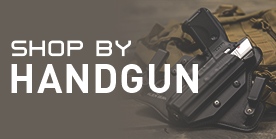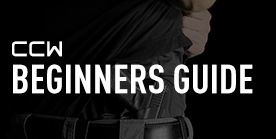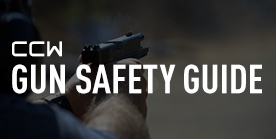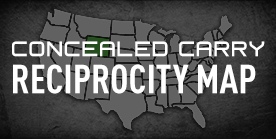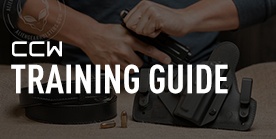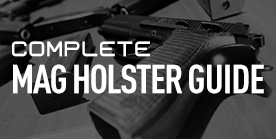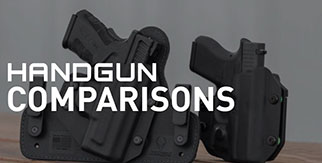
The Complete CCW Training Guide
Core competency in concealed carry practices is fundamental in not just getting the most out of your ccw equipment, but prevailing in the rare instance you may be called upon to use your concealed carry firearm.
Basic Holster And Equipment Safety – Part 1
• Objective A – Familiarize Yourself With Your Holster • Objective B – Get To Know Your Everyday Carry Handgun
Basics of Pistol Marksmanship – Part 2
• Objective A – Find A Range • Objective B – Get Ready To Go To The Range • Objective C – Prepare To Fire • Objective D – Troubleshooting Basic Marksmanship
Training Exercises – Part 3
• Objective A – Splitting Rounds Between Targets
Cover And Concealment – Part 4
• Objective A – Finding And Using Cover And Concealment • Objective B – Moving From Cover To Cover
Home Defense Preparation – Part 5
• Objective A – Home Defense Drills
Basic Holster And Equipment Safety – Part 1

Let's break down a basic training plan to take a concealed carrier with zero experience with pistols to a basic level of competency. We cannot make expert and advanced concealed carriers – that's your own job. The hope is that with a basic set of fundamentals, you can develop the motor skills and mindset necessary to operate competently and safely in a self-defense environment.
Disclaimer: This course of recommended basic instruction will not make you Superman (or Superwoman). What it will do is develop the basis of training and familiarization with your firearm that you will need to advance and continue with tactical concealed carriage.
No training course in existence will guarantee success in combat. You can only hope to increase your level of preparedness to the point where your instincts are more reflexive and routine.
Realistic Expectations: To go from newly minted concealed carrier with ZERO experience with a pistol (outside of the average state-mandated CCW course) to a reasonably competent and prepared concealed carrier.
What you'll need- :
- Valid CCW Permit
- Everyday Concealed Carry Pistol
- At Least 2 Pistol Magazines (If Pistol Is Preferred)
- High Retention Inside The Waistband Concealed Carry Holster
- Pistol Cleaning Gear
- Water (Stay Hydrated)
- IWB Magazine Carrier
Motto: “Slow is smooth and smooth is fast.”
Objective A – Familiarization With Equipment

Objective A starts with knowing your equipment intimately. Take out your owner's manual that comes with your pistol or revolver. Read it. If you aren't committed to knowing your everyday concealed carry pistol, nothing else in this article will really apply.
At home, in a quiet environment, take out your concealed carry pistol and rack and hold the upper receiver back. Visually inspect to ensure that there is no round in the chamber. Eject magazine. With the firearm confirmed to be free of ammunition, put it into your inside the waistband ccw holster.
Put your IWB holster into your waistline.
Check the retention of the holster to ensure it holds your pistol at a retention level you're comfortable with. If there's too much retention to the point where it's hard to take out the firearm and put it back, loosen any of the retention bolt elements (usually with an Allen or hex wrench depending upon make or model of holster) until your pistol is held firmly in the holster but can be smoothly withdrawn and re-holstered.
During this phase of holstering/re-holstering, always focus on keeping your finger clear and off the trigger. This is to reinforce the concept that you are to always keep your finger off the trigger until you are ready to fire.
Also focus on keeping the barrel of the firearm facing outboard from you. So, while drawing, attempt to orient the barrel to your 12 o'clock (straight ahead). Don't focus on speed – focus on form. The more comfortable you feel with drawing your pistol and getting it outboard, the faster that motion will become.
With finger off the trigger, this should be the sequence.
- Stand with feet shoulder-width apart, knees slight bent, body naturally inclined forward.
- Web of hand hits pistol grip.
- Fingers curl around and grip with trigger finger straight and along the lower receiver but outside of the trigger guard.
- Pull the pistol from the holster and orient it so the barrel is facing straight ahead.
- Using your supporting hand to steady and reinforce your shooting hand, bring the rear sight into alignment with your dominant eye.
- Align the front sight post with your rear sight post.
- Focus and confirm sight picture with sight alignment.
- Keeping the pistol facing forward, bring it within a fist's breadth from your chest.
- Scan your periphery as well as straight ahead.
- Maintain muzzle awareness (where the muzzle is pointing), return the pistol to the holster. Note – your finger is still no where near the trigger.
This is one basic way to draw, target, carry, and re-holster your concealed carry firearm.
Objective B – Operator Level Disassembly
Disassemble your pistol to the manufacturer's recommendation for operator-level maintenance.
Warning: Unless you're a gunsmith, armorer, or just really, really good at firearms – do not disassemble beyond the operator-level.
If you cannot find the manufacturer's guide for disassembly or the manufacturer did not include a guide, check online with the manufacturer to find that guide and follow its recommendations.
The proper location to disassemble a pistol will be in a well lit area with a good flat surface so you can keep the components together and there is little risk of pieces rolling off the table. A mat or towel is ideal for setting parts down onto because either will help keep them from rolling.
Before beginning any disassembly of any firearm, always ensure that the pistol is completely unloaded. Do this by the following:
Step 1 - Eject the Magazine
Eject the magazine from the pistol by depressing the magazine eject button usually found on the side of the pistol grip. Some models of firearms may have a different mechanism for ejecting the magazine, so consult with your manufacturer's guide to identify where yours is and how to properly eject it.
Familiarize yourself with how the parts from the upper receiver come apart. Take this opportunity to conduct routine operator level maintenance according to the manufacturer's specifications.
Step 2 - Check to See if There is a Round in the Chamber
Ensuring that the pistol is pointed in a safe direction, pull back the upper receiver and lock it to the rear. This can be done by using your non-dominant hand to hold onto the pistol grip and use your dominant hand to pull back the upper receiver. From here, you should be able to look into the chamber where a round would be stationed if it were ready to fire. Inspect the chamber carefully to ensure there is no round. Once this has been done, you can release your grip on the upper reciever and let it slide back to its return.
Step 3 - Find the Following Core Components on Your Pistol
You need to be able to properly identify the magazine eject button, the slide release, the safety, and whichever pin or rod may be used to hold the upper receiver onto the lower receiver. Use your gun manufacturer's guide to find these parts and then locate them on your gun.
Step 4 - Remove the Upper Receiver From the Lower Receiver
Follow your manufacturer's suggested procedure for separating the upper receiver from the lower receiver. If you are having trouble following your manufacturer's guide, check on a common video source like YouTube or similar to find a step by step tutorial. Make sure the tutorial follows your manufacturer's suggestions.
Sidenote: If you end up not liking that tutorial, consider making one yourself once you feel competent in the procedure. Not only can it be helpful for you to reinforce your technique, but you could end up helping out someone else in the same situation as you were.
Step 5 - Remove the Recoil Spring and Rod Assembly, As Applicable.
Most modern pistols have some manner of recoil spring and rod. These can be combined into one assembly that is not meant to be disassembled any further – such as a Glock 19 Gen 4 – or they could very well be meant to come apart separately – like a Walther PPS. In either case, if you are ever confused as to which is which, check your manufacturer's suggestions for more information.
Step 6 - Remove the Barrel From the Upper Receiver
The barrel is usually the easiest part to remove. After the spring coil and retention rod are removed, the barrel usually slides right out. In certain match or competition pistols, there may be additional requirements but in your standard handgun (S&W M&P Shield, Glock, Sig Sauer, Ruger, etc.) the barrel comes right out.
Note: Handguns generally have spring coils that are under considerable amount of tension. Removing them can result in the spring and rod flying off when released. Please ensure the upper receiver is not directly facing your eyes or the eyes of any onlookers and definitely don't lose the spring and rod assembly.
Step 7 - Inspect the Various Elements

You probably have all the major components you need to remove for operator-level maintenance. At this point, consult your manufacturer's manual to ensure you've complied with their suggested disassembly for cleaning purposes and complete their steps as appropriate.
This is an opportunity for you to see the core components of your everyday carry handgun. This is the handgun that could potentially save your life. The cleanliness of its parts and the condition of its pieces will all play an important role in your survival and its performance.
Step 8 - Reassemble Your Pistol
Pistol reassembly can be a very easy process so long as you just back track the way you came in. In general, the barrel will be seated into the upper receiver first. Once it is situated, you will likely reinsert the rod into the spring (if applicable) and then insert that assembly so it is seated with one end on the barrel and the other in a specified notch in the upper receiver frame. Please refer to your manufacturer's guide to ensure your handgun is reassembled in the proper way and definitely consult with online tutorials and videos that follow your manufacturer's stated recommendations.
Once your pistol is reassembled, you should be able to pull the upper receiver back and have it slide effortlessly forward again. Function checks can be done without using rounds and, for beginners, this is highly recommended.
Conduct this drill until you feel confident you can reliably disassemble and reassemble your everyday concealed carry firearm.
Note: You do not need to get to “disassemble while blindfolded” or any of that other stuff. All you need to focus on is feeling comfortable with disassembly to operator level maintenance and understand how and why rounds feed through the chamber. At no point in time in Part 1 is actual ammunition ever to touch your pistol outside of the initial step of you ensuring your firearm is clear.
Fundamentals of Pistol Marksmanship – Part 2

Now that we have discussed the equipment you'll need and the process of getting familiarized with your equipment, we need to reiterate how important it is to incorporate that component into your regular training routine. This included not just holstering/re-holstering but also operator level disassembly. It was recommended that you dedicate at least one hour a day, three times a week during the initial phase to gain that basic understanding.
Now it's time to head off to the range to see where all that practice comes to use.
Realistic Expectations: At the completion of this part, you should feel reasonably competent in controlling your breathing, trigger control, and sight alignment to maintain 6” shot groupings at 7 yards (21 feet). Your attention to detail and determination will be the true result of this exercise.
What you'll need- :
- Dedicated Range Bag
- Hearing Protection (earplugs and/or headset)
- Eye Protection (safety glasses)
- 100-200 Rounds of Full Metal Jacket or similar ammunition (no +P required)
Objective A – Find A Range

Find a local gun range. It can be an indoor range or an outside range. Use a map utility like Bing Maps or Google or your preferred choice to estimate a range's distance from your location. Ideally, you want a range you can use on a regular basis on and off work days.
Find out that range's requirements to shoot. Some are private clubs and require you to undergo some mandatory or required safety training and others may require you to submit an application that gets voted on by other members. No matter what the case, pursue it if it makes sense to you.
Objective B – Get Ready To Go To The Range
Pack your unloaded gun, magazines, pistol holster, cleaning gear, water, ammunition, hearing and eye protection into a dedicated range bag. Keep your CCW permit in your wallet or purse. Get used to always having that permit with you at all times – you'll need it if you ever encounter law enforcement.
The range bag does not need to be some high-speed, low-drag bag. It can be a gym duffel or anything suitable for transporting all the aforementioned items. However, once you put those items in there – it's now dedicated to just your range equipment.
You don't want to make the mistake of using it to store your daily sundries and then find out you have a bullet in a side pocket when you go through the security line at the TSA. It happens more often than you'd expect so it's probably best to just rule that bag out completely for any other use than the range.
At the range, remember that the rules of firearm safety always apply.
- Treat every weapon as if it were loaded.
- Keep your finger off the trigger until ready to fire.
- Do not aim at anything you do not intend to shoot.
- Know what is in front of and directly behind your target.
Reinforcing these basic rules at every step in the process will significantly reduce your chances of a negligent discharge.
Objective C – Prepare To Fire

When you get to your station, load two magazines with three (3) rounds each.
Place your at the 7 yard line (21 feet).
Now it's time to prepare your pistol to be drawn and fired from your IWB holster.
- Equip your favored gun holster.
- Load the first magazine into your pistol.
- Load a round in the chamber.
- Place the handgun into your IWB concealed carry holster.
A recommended first time position to place your IWB will be referred to as the “3 o'clock” position. It is directly on the waistline closest to where your dominant hand rests against the seam of your trousers. As time progresses and you gain experience, you may switch up the position to experiment with what works best.
Feet should be shoulder-width apart, knees slightly bent. You should be relaxed and focusing on nothing else but what you are about to do. If your feet are along a perpendicular plane, that's called an isosceles stance. If your feet are staggered with your non-dominant foot forward and your dominant foot slightly back, that's called a Weaver stance. You can choose which feels more comfortable for you.
Ensure that the firing line is clear of other shooters or obstructions and the range officer has signaled that you are safely able to discharge your pistol.
Use the palm of your hand to gain leverage over the back of the pistol grip and slowly wind your supporting fingers about the grip, leaving your trigger finger straight and along the lower receiver directly above the trigger well.
With your non-dominant hand, wrap your fingers around the pistol grip so they overlap your dominant hand. You can place your non-dominant hand's thumb flush across the natural recess between your dominant hand's thumb joint and your wrist. Your non-dominant hand's thumb now should be able to rest against your dominant hand. You should not have any fingers resting on the upper receiver.
Line up the rear sight posts so the target's bullseye is between them. Then adjust the pistol to line up the front sight post into the center between the rear sight posts. This is just one of many ways to gain sight alignment.
The most preferred method is to simply jut the pistol straight out from your body so the front sight is already aligned with the rear sight and then lift your shoulders so it is aligned with your eye. The sooner you can make this transition, the better. For now, we're focusing on pistol marksmanship.
Once you have sight alignment and sight picture, focus on that front sight post. Because it's difficult to focus on both the target and the front sight, do your best to align the front sight post on the target and then focus slightly past that to the target. The target and the sights should be about equally slightly out of focus.
Let your trigger finger drop slowly and naturally until it curls around the trigger. The pad of your trigger finger should be pressed flat against the front of the trigger. Squeeze slowly, bringing the trigger straight back towards you. If you notice your front sight post sway to the left or right, slow down the squeeze and regain focus on keeping that front sight post directly over the bullseye.
If you are operating a single-action/double-action, you will see the hammer come back, reach its apogee, and then slam down. A round will exit the front of the barrel and hopefully strike the target where the front sight post is pointing.
If you operate a striker-fire pistol, the round will exit much more abruptly.
You may involuntarily jump when the trigger is pulled. That's okay. That's normal. You may notice your adrenaline race from the loud noise and the recoil. That's okay, too. You will learn, in time and through practice, that this is to be expected. You can't learn this without practicing, though.
After the trigger is pulled, do not immediately pull your finger off the trigger.
Slowly release pressure on the trigger until you either hear or feel an audible “click”. This is known as a trigger reset. You don't need to pull your finger off the trigger any further than this if you intend to fire a second round.
Realign your sights if they wandered. Focus on getting that front sight post directly on the bullseye.
Before you want to take the second shot, exhale again. Make minor adjustments to your sights, if necessary.
Squeeze the trigger slowly until the second round goes off.
If you're firing an SA/DA pistol, you'll notice that the second trigger pull is much lighter.
Your upper receiver should be locked into the back position as the magazine should now be empty. Release the magazine by pressing the magazine release button. Use your non-dominant hand to catch the magazine and place it either on the table or in your pocket. Visually inspect your pistol to ensure there are no rounds remaining in the chamber. Return the upper receiver through the slide release. Place the pistol back into your holster.
Hopefully, you see all three rounds have impacted the target. Ideally they will form into a “shot group”. Do you have a tight shot group with all the rounds within a 3” radius from the center or are they spread all around?
The three major places you'll have to work on, likely, is breathing, trigger control, and sight alignment/sight picture.
Objective D – Troubleshooting Basic Marksmanship

If the shots form a lateral line across, you may be dealing with trigger control. The way you pull the trigger is skewing your shots across.
Recommendation: If this is the case, focus on trigger control.
If the shots vary widely up or down, there's a good chance your breathing needs work.
Recommendation: Practice a full exhale before final alignment and your shot. If you feel more comfortable holding your breath on the inhale before squeezing the trigger, try that.
If they're all over the place – it's likely a mixture of all three. Don't worry – focusing on the basics and performing each action slowly and deliberately will improve your performance. A common problem is slight deviations before the round discharges from the pistol.
Recommendation: Slow down your shooting and practice aligning the sights with the bullseye. Ensure the front sight post is flush with the rails of the back sight posts. Next, focus on getting the front sight post in the middle of the two back rails. This ensures that where ever your front sight post is located, just above that point is where the round will likely impact.
Mark your shots after each volley so you can re-use the same target. Perform this exercise again. When your shot groups begin to have a predictable nature to them, you can better remediate any deficiencies. You can't fix what you don't know is broken, yet.
Concealed Carry Training Exercises – Part 3

Part 3 is where we transition heavily into focused training. Before you begin focused training, you need to be proficient in all the preceding steps. Additional training will be of no use if you don't understand your pistol, holster, and how you shoot.
- Focused training exercises help break the monotony of simple target practice and switch it up into little mini-games. Here's a few ideas for different techniques you can work on mastering:
- Working with night sights
- Lasers and optics where applicable
- Moving in and out of confined narrow spaces
- Using cover and concealment
- Communicating with others
- Differentiating friend from foe
- Reaction drills
Realistic Expectation: You will be familiarized with some of the shooting drills helpful for going into scenario-driven training.
What You'll Need: You'll need to carry over or replenish the things used. So if you used 200 rounds of ammunition, replace that. Definitely clean your firearm if for no other reason than practice alone.
In the Marksmanship portion, we focused on the core principles of firearm safety and putting rounds on target. Hopefully, you have practiced enough at this point to reliably discharge three rounds in a shot grouping at 7 yards.
If you're still having trouble on it, ask a range officer or instructor for assistance.
- The five most likely conditions a concealed carrier will meet are:
- In or on his own property
- Night time environment
- Inside or directly beside his vehicle
- At his place of work
- While inside a convenience store or pumping gas
Now don't get us wrong, there are a bunch of different options out there. This doesn't cover all of them. And before we go into each of these highly specialized scenarios, let's discuss a few things you can do at your average indoor or outdoor range.
Objective A – Splitting Rounds Between Targets

One of the worst things a gun owner can do is fall into complacency. An example of this is when a gun owner just looks directly ahead of himself (12 o'clock) while neglecting the other potential angles of attack.
Indoor ranges will probably want you to consult with them before taking up multiple lanes. It's also a good idea to check the conditions at your outdoor range and make sure it's alright with the range safety officers prior to attempting these exercises. That said, if you're able to space two targets at your 3 o'clock and 9 o'clock respectively, this is a great drill.
- For this exercise, load two magazines with four rounds each. Place one in your pocket or a dedicated magazine holster you plan on carrying with you.
- With your loaded firearm holstered in your concealed carry holster, turn with your back facing the targets.
- On “go”, turn around and draw on the first target.
- Put two rounds in the first target and then scan to the second target and fire two more rounds.
- Drop your magazine from the pistol
- Insert another loaded magazine.
- Fire two more rounds in the target you shot last and then transition to the other target and do the same.
- Scan left and right.
- (Optional) Reholster your firearm.
This drill will hopefully familiarize you with the idea that not all targets are directly placed in front of you and you may need to scan and adjust your fire. Advanced variations of this include placing the targets at further distances and lopsided distances (Target 1 – 5 yards, Target 2 – 8 yards, etc.).
It's also fun and practical to time yourself. There are competitive timers you can use or you can have a friend time you.
Remember: The fundamental rules of firearm safety always apply. Do not draw your firearm until you are facing the physical target and always keep your finger clear and off the trigger until you're ready to fire. And, when working in a range populated by other shooters, always ensure that the range is “hot” and you are cleared to fire your weapon before proceeding to shoot.
Also, in the beginning, don't focus on speed. Focus on hitting the targets and getting good shot groupings. Focus on drawing your firearm smoothly and safely. These are more important than speed when learning this technique.
Cover And Concealment – Part 4

If you've been sticking to your training schedule, you've come a long way already. At this point, you can reliably disassemble your concealed carry handgun, draw and re-holster safely, put rounds on target at 7 yards, as well as split your shots between two targets spaced apart.
In this part, we're going to talk about the next step – getting ready for the real deal. Detecting cover versus concealment and using them with movement.
Realistic Expectation: In an actual firefight scenario, you do not want to be caught flat-footed. Falling into the mistake of going toe-to-toe with a violent bad guy should be avoided at all costs. In any scenario where you are more than 20 feet from an attacker, you want to take cover. In this section, we'll talk about what cover is and isn't – and what drills you can do to get yourself familiarized with cover versus concealment.
What You'll Need: You'll actively need your inside the waistband (IWB) concealed carry holster and concealed carry handgun. The rest, you'll be drawing from your surroundings. If you have access to a nice nature preserve or park where it is legally permissible to carry, it may be helpful to go for a walk while we illustrate some ideas.
Objective A – Finding And Using Cover And Concealment
Practical Exercise: Parks And Recreation
As a law-abiding concealed carrier, you are generally allowed to walk through State and Federally maintained parks with your concealed carry firearm. What you will not be doing is drawing your pistol while we go through this section. The reason why we're taking a detour into the woods is for two reasons –
1. You can get a better idea of the natural fauna and foliage that is in your area
2. You can see how that and natural features of the landscape can aid your chances of survival.
What, in your surroundings, do you think can deflect or stop a bullet from hitting you?
- Here's several ideas:
- Rocks, stones
- Earthen mounds
- Fallen trees
- Structures made out of reinforced wood, brick, or concrete
- Dumpsters
When you're out on your walk, look at how the earth naturally forms gullies and troughs. These can be useful in taking immediate cover. They can also leave you exposed to attacks from other angles.
1. Pick a direction and imagine that bullets coming from that direction. 2. Walk over to a suitable place where you believe you could readily take cover. 3. From this place, look around to see where the next, nearest point of cover is. Your goal should always be to move away from the source of gunfire. 4. Walk over to the next place where you believe cover may be obtained. 5. Is this location as suitable as you thought it would be?
This is a real issue that affects those who've been in firefights. Often times, a place of cover or concealment may appear to be more appealing than it actually is.
Also, because you're in nature, notice the sound your feet make as you walk to your next point of cover. Just the simple act of movement probably did a lot to give away your position.
So, you'll see, movement comes at a price: it can potentially reveal your position to a shooter and it can cause a lot of commotion. But, if you stay in your old spot for cover, your attacker may move in and try to take advantage of that. So, there is a sacrifice that must be made. Food for thought.
Objective B – Moving From Cover To Cover
In a firefight, you need to keep moving away from the action whenever possible. There are two basic types of movement from cover:
- Sprinting
- Crawling
You should never leave a place of cover unless you are moving to another point of cover. Staying out in the open and leaving yourself exposed is a very bad idea. Sprinting from cover is fast but at the sacrifice of exposure to your enemy. Crawling is slower but minimizes yourself as a target.
Ideally, you should have identified precisely where you intend to move. A good rule of thumb when sprinting to a new place of cover is the saying, “I'm up, he sees me, I'm down.”
By the time you finish saying that sentence, you should be on the ground or where you intend to take cover. This is not a firm rule but a light guideline. This is also a FANTASTIC drill which is both great for cardiovascular activity.
Home Defense Preparation – Part 5

For this last piece of the puzzle, we're going to dedicate a section to home defense. This is by far the most likely place you will encounter an actual self-defense scenario. It only makes sense to both prepare a plan and practice that plan to ensure the safety of yourself and your family.
Realistic expectations: At the conclusion of Part 5, you should have the basics you need to continue training to suitable proficiency in concealed carry firearms. From here, it's recommended you also check out parts of our series on “making a plan to own and carry everyday” for more indepth ideas for training.
What you'll need- :
- Your concealed carry pistol (unloaded)
- Inside the waistband concealed carry holster
- Optional accessories such as a red laser sight and/or flashlight attachment
Movement around your own home is imperative in a self-defense situation. If you have family members located in adjacent sections of your house, make a plan for them that covers two basic situations:
- Movement is not recommended or possible.
- Movement is necessary.
- The situation rapidly changes and you are forced to go from 1 to 2 or vice versa.
Determining whether movement is necessary will be largely determined by whether the active threat is inside the house with you. In close quarters, it may not make sense to have your children or other occupants move to your location and take shelter.
If the threat is not yet inside the house when it is detected, you have initiative. Thus, if it makes sense, move your family to a central location that is defensible. Develop call words and strategies to communicate quickly and efficiently – much like a quarterback calling a play.
For instance, if you call out “home base”, your family needs to know that means they should all individually attempt to move to a specific room and shelter there until the situation passes.
If you have a spouse or a child that you want to use a firearm in support of you, it's advised you dictate an “all clear”. The worst thing that can happen is for them to hear gunshots and you rush back in the room only to inadvertently get taken out.
Alternatively, if they decide to “shelter in place”, you should have an “all clear” to sound to let them know it's safe to come out.
Objective A – Home Defense Drills

When practicing home defense drills, always visually and manually inspect your concealed carry handgun to ensure that it is unloaded. Teach those around you to also do the same to ensure everyone's safety.
Call for law enforcement.
As soon as a break-in is suspected, don't wait for visual confirmation. Immediately contact emergency services. The sooner the call goes in, the sooner the timer starts for police to arrive. In the meantime... You've got a plan.
Practice clearing doorways and rooms using calls.
If you call a word and there is no answer from inside, you can't assume the person inside is a bad guy. On the same token, you cannot assume the room is safe, either.
•Don't reveal your silhouette in a doorway unless you intend to clear it. •Don't leave your back facing an open hallway while clearing a doorway.
You should see that there's immediately a problem that presents itself – you can rarely achieve both alone and at the same time.
That's why it's important to encourage sheltering in place and taking up defensive positions inside rooms until police can arrive. This is the path of least resistance. If you have someone in your household that can cover you while you clear a room, that at least improves chances you can respond adequately to an active threat.
Consider using a gun-mounted flashlight or practice clearing with a flashlight in hand.

Clearing doorways and darkened areas is extremely tense. This is made all the more tense if you can't see what you're aiming at. Using a flashlight is important but it's also important to practice using it.
Practice moving to/from “trouble” spots.
If you're in the living room and someone breaks in through the back door, find the easiest way to achieve concealment and still cover their likely approach with your field of fire.
For reference, a “field of fire” is the area you are able to safely cover using your gun. Ideally, it's an area 15 degrees or less to either side of you. If your positioning were like the face of a clock and 12 o'clock is directly in front of you, you want your field of fire to ideally be no greater than 11 to 1 o'clock respectively.
To truly embody this, you need to figure out how you would break into your house. Knowing the likely routes you would take will help you figure out how you can respond to them. In turn, armed home invasions can happen at any hour. So, practice different variations from places such as the kitchen, living room, study, or bedroom. This will help you get a better understanding of your vulnerabilities in responding to a home invasion scenario – and hopefully turning them into advantages.
Slow is smooth and smooth is fast.
In a home defense situation, you're going to want to move fast. But you don't want to be careless. If you're injured or killed, you can potentially jeopardize the rest of your household's ability to defend themselves. Practice slow, deliberate movements no matter how rushed and fast you want to go.
Your muscle memory will ultimately be the clincher in your ability to prevail in an actual home defense scenario. Practicing steady movements, adhering to safety, and having an understanding of the layout of your home and location of your family will all prove to be just as pivotal as your practice with your firearms.
In conclusion, if you've followed this guide all the way through, you likely have the basics you need to feel confident and competent in concealed carry practices. Make sure to attend any firearms courses you feel will best help you learn more advanced skills such as scenario-driven events, vehicles, et cetera.
It's impossible to be prepared for everything, but if you've trained and you're carrying your concealed handgun, you'll at least be able to respond to the emergency.
Back to Top.
 |
About The Author James England (@sir_jim_england) is the contributing editor for Alien Gear Holsters. He is a veteran of Operation Iraqi Freedom and private defense contracting in Afghanistan. |


